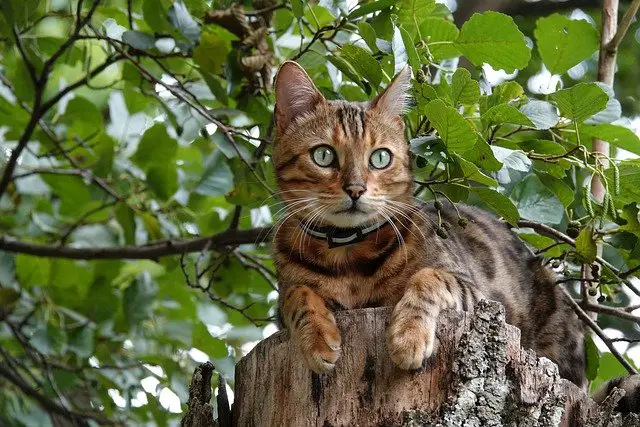Often advertised by breeders as being hypoallergenic, the Bengal cat is a hybrid domesticated cat. Unfortunately for allergy sufferers, while the Bengal is easier on allergies than some, it is still not 100% hypoallergenic.
Are Bengal Cats Hypoallergenic?
Bengal cats are not hypoallergenic…and here’s why…
When someone has an allergy, it means that their body’s immune system is oversensitive and identifies non-harmful particles as being harmful, and launches an immune reaction.
For example, most people’s immune systems can determine a harmful particle like a viral particle from a non-harmful particle like a cat dander particle. When someone has cat allergies, though, their immune system mistakes a protein present in the cat’s dander for a harmful particle and launches an immune response.
So, it is all about dander?
Not exactly…
When someone is allergic to cats, they are allergic to the proteins in the dander and those proteins are also present in saliva and urine. So, there is no way to eliminate the allergen that causes the allergic reaction.
Is the Bengal cat hypoallergenic? Not technically. The Bengal does groom much less often than other cats, which means less saliva and less dander. Less saliva and less dander do not make Bengal cats hypoallergenic, but they do make them more tolerable for allergy-sufferers.
The Bengal Cat
The Bengal cat is a hybrid cat bred from an Asian Leopard Cat and the domestic shorthaired cat. Bengals have short silver, snow, or brown fur that is either marbled or spotted. The rosette pattern on the Bengal coat can be of various shapes.
The Bengal cat resulted from accidental breeding but when breeders discovered that leopard cats were not susceptible to the Feline Leukemia Virus, researchers wanted to find out if this trait was heritable by mixed offspring.
Today, the domestic Bengal cat should be at least four generations removed from pure Bengal bloodlines.
Domestic Bengals are muscular, athletic, and graceful. They weigh between eight and fifteen pounds and stand between eight and ten inches tall. Despite their size, this big housecat has an affectionate personality but does require more exercise than your average housecat!
What Does Hypoallergenic Mean?
Breeders often advertise the Bengal cat as being hypoallergenic – but what does that mean?
When something is labeled “hypoallergenic,” it has a low likelihood of triggering an allergic reaction.
Reducing Allergens
If you want to bring a Bengal cat home but you suffer from allergies, there are some steps that you can take to reduce your allergen exposure. These steps include:
- Using an Air Filter
- Feed a Balanced Raw Diet
- Regular Brushing
- Regular House Cleaning
Using an Air Filter
Using a HEPA air filter can go a long way to keep down the number of allergens in your home, including pet hair and dander! Be sure to buy a true HEPA filter, though, so that it removes 99.9% of particles from the air, including pet dander.
Feed a Balanced Raw Diet
Feeding a balanced raw diet that is rich in omega fatty acids is one of the most important things that you can do to keep your Bengal cat healthy and to reduce the number of allergens floating around in the environment, is to
Omega fatty acids will keep your Bengal’s skin healthy so that they experience less dry skin and consequently, less dander and saliva get released into the environment.
Feeding a raw diet is also beneficial because it does not contain the junk and fillers in commercial kibble foods. Fewer fillers mean a healthier cat, and a healthier cat means less fur shed and fewer allergens around your house.
If you are unsure how to feed your Bengal a healthy raw food diet, it is a good idea to talk to your breeder about what they feed their cats. You can talk with your veterinarian or a feline nutritionist who can help you create a healthy diet plan if you do not have access to a Bengal breeder.
Regular Brushing
Regular brushing is another step you can take to reduce the concentration of allergens in your home. When you brush your Bengal, dead and loose hair gets brushed out of their coat which (once again) means fewer allergens released into the environment.
Regular Housecleaning
In addition to brushing your Bengal, regular housecleaning will keep hair, dander, and other allergens from building up in your home, which (once again) means fewer allergens in your home and fewer allergy triggers.
Conclusion / Summary
The Bengal cat is an interesting breed, and while they expose allergy sufferers to fewer allergens when compared to other domestic cats, this is still not a 100% hypoallergenic breed. There are, however, some things that you can do to reduce the allergen exposure in your home, including:
- Using an air filter
- Feeding a healthy balanced raw diet
- Brushing your cat regularly
- Regular house cleaning.
[su_box title=”Affiliate Disclosure”]This website is supported by its readers. Please assume that all links are affiliate links. If you make a purchase from one of the links we will make a commission from Amazon. Thank you.[/su_box]




